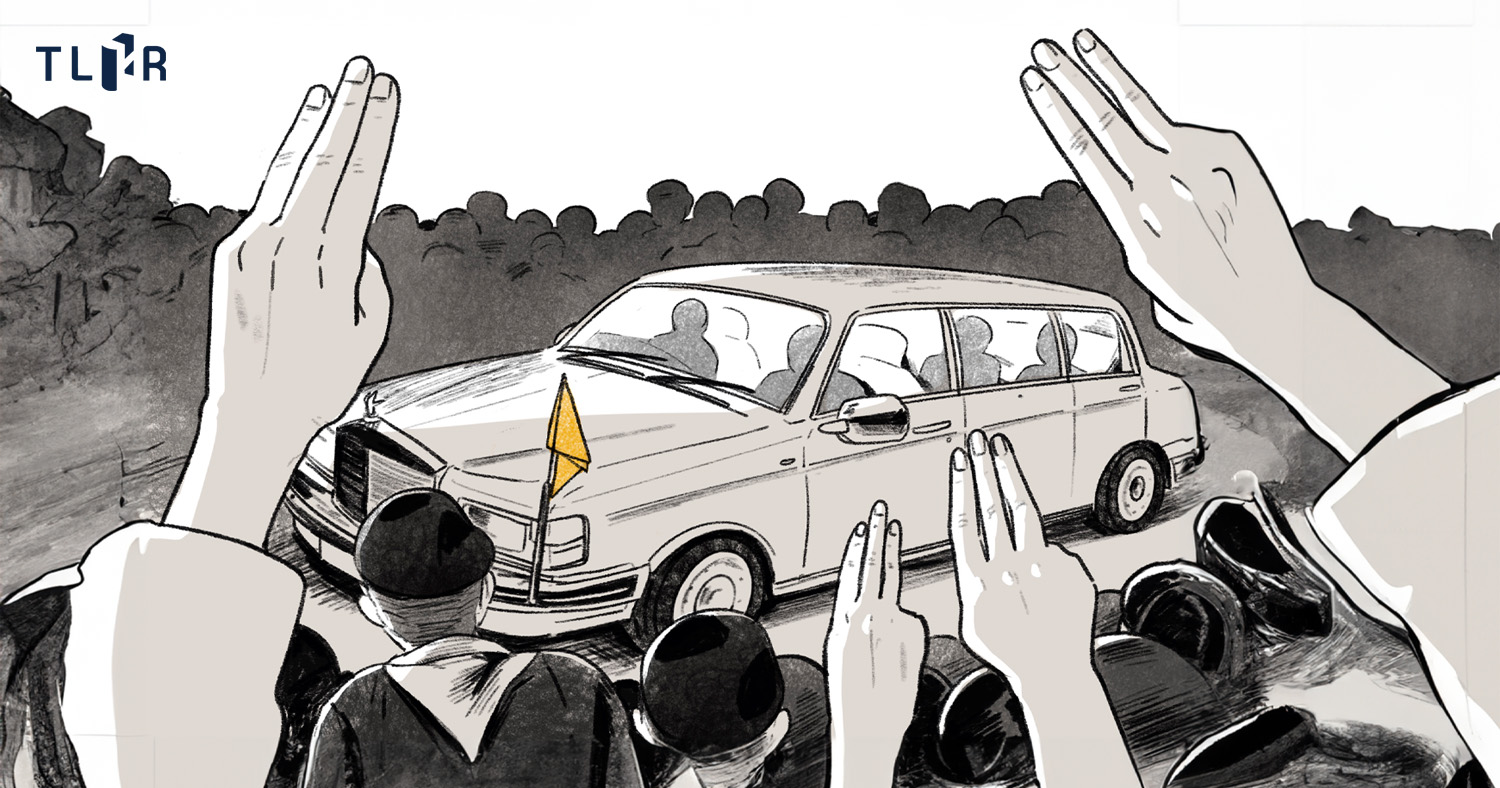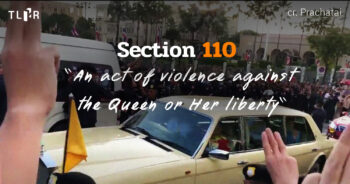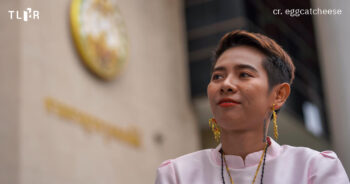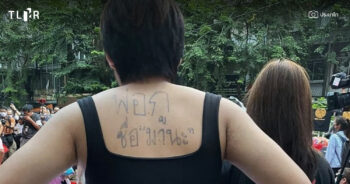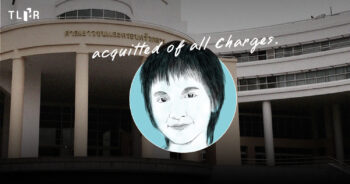On June 28, 2023, at 9:30 a.m., the Criminal Court scheduled a hearing in the case of five activists, namely Ekachai Hongkangwan, Boonkueanun Paothong, Suranat Paenprasert and two other people charged for an assault on the Queen’s liberty. The combined charges include Section 110 of the Criminal Code for violations against the Queen or her liberty, and Section 215 of the Criminal Code for inciting chaos in the country, the charge for obstructing public paths and traffic.
.
This case is considered one of the most important cases in Thailand’s political sphere as the penalty of this case is severe and the defendants could face 16 to 20 years, life time imprisonment or even the death penalty for allegedly violating the Queen’s liberty and her well-being.
.
The charges were made by Sarayut Sangwanthong and Pol.Lt.Col.Pitak Ladlai. The cause occurred on October 14, 2020, during the #14October rally of the “Khana Ratsadorn 63” around 5:00 p.m., while the main group of demonstrators was moving from the Democracy Monument area to the Government House area of Phitsanulok Road. A number of demonstrators had gathered waiting for the main group. Immediately, the oncoming royal motorcade procession of Queen Suthida, along with Prince Dipangkorn Rasmijoti passed through the protest area. During this procession, there was an incident that led to police officers blocking the line between the protestors and the royal procession. Later on, five people were prosecuted for this incident.
.
After the prosecutor had ordered the indictment on March 31, 2021, the Criminal Court held sixteen days of hearings between November 2022 and March 2023 to listen to witness testimonies, thirteen days of which came from prosecution witnesses and the remaining three days for defendants’ witnesses.
.
.
⭕ Overall, the public prosecutor brought a total of 22 witnesses to testify: 2 of the accused, 8 police officers from the Dusit police station who were at the crime scene, 4 crowd control officers, 4 police officers from other police stations and government agencies, 4 witnesses from the general public/members of the monarchy protection group, and eye witnesses.
.
The defendant brought 7 witnesses to testify. Not only the five defendants, but also the former members of the House of Representatives from the Move Forward Party who submitted a motion to open a debate in the Parliament on the problems from the royal procession incident. Defendants also brought in the media who were present at the scene to testify as witnesses.
.
.
⭕ During the litigation proceedings, the plaintiff tried to accuse the five defendants and others of trying to obstruct the procession by going down on the traffic surface on Phitsanulok Road to the foot of Chamai Maruchet Bridge, which was designated as the route of Queen Suthida’s royal journey for performed religious ceremonies to make merit and present robes to monks in the Royal Kathin ceremony at Ratcha Orasaram Ratchaworawihan Temple.
.
The 1st defendant (Ekachai), 2nd defendant (Boon Kueanun) and the 5th defendant stood in front of the protesters, which includes the 3rd defendant (Suranat) and the 4th defendant, all together using force to push the front line of the crowd control police officers which set up a row to cover the front of the royal car. The prosecution claimed that the third defendant had ordered the crowd to sit on the road, causing the police to be unable to move the royal procession forward. Additionally, the 2nd defendant used a megaphone to incite the protesters, while the 1st, 4th, and 5th defendants held up a three-finger symbol to show the symbol to the royal procession.
.
The defendants argued that no one was aware that a royal procession would pass through that route before. No one knew about this procession, including reporters of the rally and the police. No officials were dressed or prepared to act in such a way as to illustrate that a royal procession would occur. The defendants argued that the incident occurred only because the protestors understood that the authorities would crack down the demonstration in that area. Defendants argue that there was no assault on either the royal procession or government officials, and that the entire procession was able to pass through quickly.
.
The defense also argued that no one in the area was the leader of the rally, but were rather a group of demonstrators waiting for others to arrive. All five defendants were not organizers of the assembly or leaders. They didn’t even know each other. There was no plan or preparation whatsoever to obstruct the procession.
.
In terms of explaining the behavior of the defendants, the defense argues that the case of spreading arms of the 1st and 2nd defendants was meant to show that they are unarmed. The 2nd defendant’s use of a megaphone was not to incite the protestors, but rather to inform the protestors to step back upon learning of the royal procession. As for the 3rd defendant, he told protesters to sit down in order to reduce clashes with officials, not to obstruct the royal route. The difficulty of the procession to move was not caused by the protestors, but rather the police van used to block the path of protestors.
.
Additionally, witness examinations indicated the “irregularity” of this event. The assembly of the people’s groups was announced almost a month in advance, and yet, on the day of the incident there is a procession to perform Royal religious ceremonies to many members of the royal family, including King Rama 10 and HRH Princess Maha Chakri Sirindhorn. Based on the testimony of the police, many royal processions have changed their routes in the past, so it is not clear why the Queen’s procession continued to take the route that passed through the protesters in front of the Government House. Additionally, information during the witness examination revealed that the director and deputy director of the Dusit Police Station reported via radio that Phitsanulok Road could not be used as a royal route. The preparation for taking care of the royal procession by officials at the scene was also unusual.
.
Later this event was cited by the government as part of the declaration of a serious state of emergency on the morning of October 15, 2020. The police requested arrest warrants for the 1st and 2nd defendants immediately after a PDRC’s ex-guard reported the incident at night. Even though it is an important case, there are many details and evidence to reveal before issuing such arrest warrants.
.
Due to the case’s importance as a legal question of first impression, as well as the amount of witnesses and the severe penalty if defendants are deemed guilty, the Thai Lawyers for Human Rights have reported a detailed observation record of the witness examinations in this case in order to record the events from the point of view of the various eyewitnesses.
.
.
📌 Read all the witness testimonies of this case in Thai at https://tlhr2014.com/archives/56935
📌 Read more on the interview with “Suranath” and the indictment from “Royal Motorcade” incident in Thai at https://tlhr2014.com/archives/27626
📌 Read more on “Suranth” life prior to being charged for violating the well-being of the Queen Suthida who was a hero of the youths in Thai at https://tlhr2014.com/archives/22814
